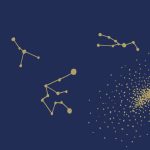Introduction
Students look to the sky and find stars that make up a constellation. Students will learn about constellations and to describe the role of celestial objects in the traditions and beliefs of selected cultures and civilizations.
Learning Objectives
- Students will learn about constellations
- Students will learn how different cultures have created stories around constellations
- Students will learn to recognize commonly known constellations
- Students will learn to look for constellations in the night sky
Vocabulary
- Constellation
- A cluster of stars in which humans see a particular pattern.
Introduction to Constellations
- What is a constellation? A constellation is a recognizable pattern of stars that can help people orient themselves by looking at the night sky.
- Are the stars in a constellation close together? The stars might not actually be close together but because of the distance from the stars to Earth, it appears as though they are.
Constellations in Culture
There are constellation stories and folktales stemming from many different cultures in society. From the ancient Greek and Roman cultures to many Indigenous cultures, such as Maya, Dakota, Inuit, and Cree.
Inuit have used the night sky as navigation during the long winter months for thousands of years. Though many cultures used the star Polaris, part of the constellation Ursa Minor, as a navigation point due to the latitude in the Arctic, many Inuit used the constellation of Ursa Major (the big dipper), known to Inuit as Tukturjuit for orienting and navigation. Tukturjuit translates to “the caribou,” as the seven stars that make up the constellation resemble a number of caribou.
Reading Activity
Have students read the following article found on page Ininiw Acakosuk, The Cree Stars by Wilfred Buck.
Research Project
Students will research one constellation. They are asked to learn about the constellation, its name and origin, and a cultural story around it.
Research questions:
- Find a constellation. What is its name? Does it have other names in other cultures? Where is it located?
- What are some stars or other constellations close to your chosen constellation?
- Find a story about the constellation from another culture and share the cultural significance of the constellation.
Video Activity
Once students have finished the research component of their project, they will be asked to create a small video (2 to 3 minutes in length) to share their findings. Follow this tutorial – Video Production for Social Media – on how to make and put together a short YouTube video.
Game: Exploring Constellations
The following game, Star Scribe, allows users to explore the Earth’s lunar surface and the surrounding stars. During their expedition, users will also discover constellations discovered by Indigenous cultures. They can also listen to spoken star knowledge connected to those constellations as shared by Ininiw (Cree) astronomer Wilfred Buck. Additionally, there is a Roblox edition of Star Scribe where users can learn about Inuit star knowledge by scanning out a map of different constellations as they find them in the sky.
Star Finder
As students learn more about constellations in the night sky, encourage them to look for different constellations using the star finder. Ask questions like: Can you view all of the constellations in a single night? Is visibility of certain constellations determined by the time of the year or in which hemisphere we live in?
Using the provided PDF, students will make a star finder of their own to examine and find constellations in the night sky.
Conclusion
Have students share the video they created with the rest of the class.

